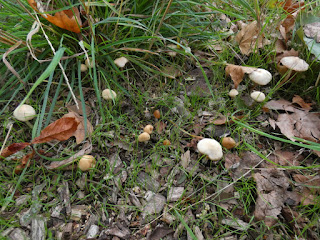... one flying around ...
... and one cheekily perched on the barracks tower where the Peregrines often go -- of course these were away at the time. It wouldn't turn round to show its face, but the variegated feathers on its back are clearly those of a young bird.
Robins have started singing again after their late summer break. Both sexes will continue to sing all winter and spring, as the couples have broken up and each one is defending his or her own territory.
A Long-Tailed Tit perched on a twig near the allotment ...
... and there was a Blue Tit farther down the hill.
Again, both of them had chosen hawthorns, which have some special attraction for tits.
The Feral Pigeons near the Dell restaurant allow the pigeon-eating Lesser Black-Backed Gull to get quite close to them, as they are confident that they can fly away if he tries to grab them. Usually they're right, as he can only get them when they stop paying attention.
Anyway, he didn't make a catch and had to settle for a crayfish.
A Lesser Black-Back at the Round Pond had somehow got a very large fish. Virginia snatched this hasty picture on her mobile as she was going by.
Coots just can't stop making nests. This one is in a bizarre place even by the standards of Coots, in the drenching spray of one of the fountains in the Italian Garden.
The Black Swan preened its elegant feathers. It has its second set of flight feathers: the first set had black tips, and there are still slight dark traces on the tips of these. When it moults again next year the new feathers should be pure white. Actually this is a most impractical arrangement, as black melanin in feathers stiffens them up and makes them less likely to get frayed. Many pale birds have evolved dark wings to resist wear.
A Common Carder bee hung upside down from a borage flower at the back of the Lido.
The patch of wood chips under the plane trees south of the Physical Energy statue constantly produces a wide variety of mushrooms. At least ten species have appeared here. I thought at first sight that these were Fairy Ring mushrooms, but they don't look quite right for that.
Here is a view of the underside of a cap. The stem splits easily into stringy fibres.
Update: Mario writes, 'The mushrooms on the wood chips are Brittlestem mushrooms (Psathyrella spp). Psathyrella is a fairly large genus of saprobic gilled mushrooms with dark spore prints, "snap-able" stems, and frequently hygrophanous caps (meaning the caps often change colour dramatically as they lose moisture, sometimes resulting in two-toned specimens).'
Here are some ordinary Fairy Ring mushrooms from a circle on Buck Hill.
One should avoid stepping into these circles, as there is not always a friend to pull one out if things get strange.
Engraving from William Wirt Sikes, British Goblins: Welsh Folk-Lore, Fairy Mythology, Legends and Traditions, 1880, courtesy of Wikipedia.






















































